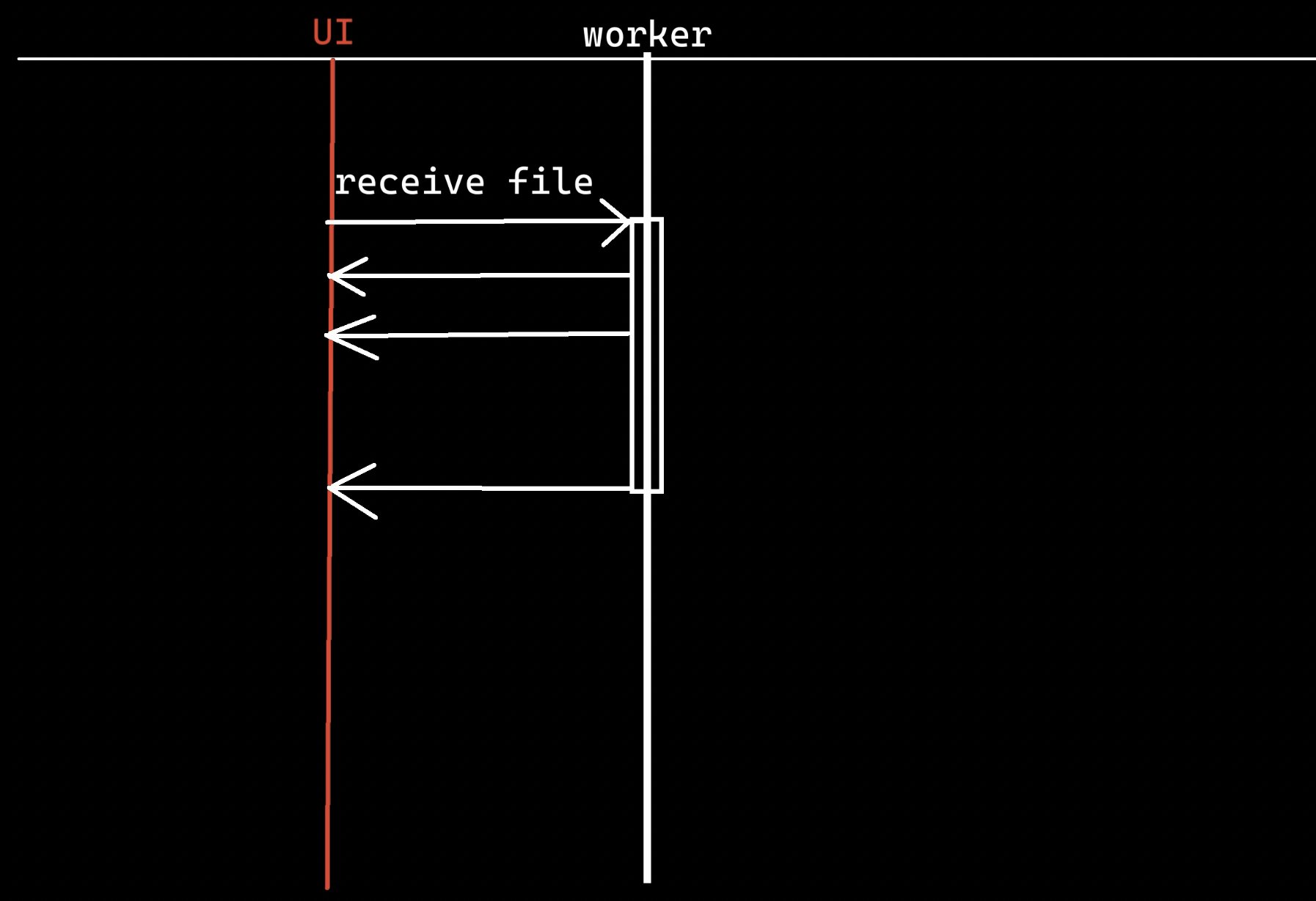以UI线程和工作线程之间的交互为切入点
有两个线程,UI线程和文件下载线程(下面成为称为工作者线程)。UI线程点“接收文件”按钮后启动工作者线程,之后两线程异步执行。假设工作者线程每下载、传输文件的10%都要通知UI线程,以在UI界面进度条显示进度。
由于两线程是异步、无关联的,那么就涉及到工作者线程怎么与UI线程交互的问题。工作者线程不能直接操作UI线程,否则会扰乱UI线程中的部件、内容等,而是要通过发送一个消息,指示UI线程自己去调整。
可以考虑设置一个回调函数。

简单示例
1
2
3
4
5
6
7
8
9
10
11
12
13
14
15
16
17
18
19
20
21
22
23
| #include <iostream>
#include <thread>
#include <chrono>
#include <functional>
using namespace std::chrono_literals;
void worker(std::function<void(std::wstring const& str)> callback)
{
std::wcout << L"doing something in " << std::this_thread::get_id() << std::endl;
std::this_thread::sleep_for(3s);
std::wcout << L"call callback!" << std::endl;
callback(L"worker called");
std::this_thread::sleep_for(3s);
std::wcout << L"worker finished!" << std::endl;
}
int main()
{
std::wcout << L"UI: " << std::this_thread::get_id() << std::endl;
std::jthread t(&worker, [](std::wstring const& str) -> void
{
std::wcout << str << L" in " << std::this_thread::get_id() << std::endl;
});
}
|
输出:
1
2
3
4
5
| UI: 1452
doing something in 8864
call callback!
worker called in 8864
worker finished!
|
UI线程ID号为1452,工作者线程ID号为8864。
而回调函数是在工作者线程中调用的。
现在我们的需求就是工作者线程要和UI线程产生关联,所以要想办法如何转移线程,让回调函数被UI线程调用。
以上程序:
- UI线程通过向线程构造函数传参,为worker函数绑定一个回调函数,这个回调函数以lambda表达式定义。
- worker函数很容易调用参数“callback”。
- 问题是,worker线程怎么通过“callback”与UI线程交互?
- 答案就是让它们以消息队列为媒介。worker线程择机(比如每下载10%)把callback和一些实时数据信息打包发到消息队列中,UI线程监听消息队列消息,只要有了,就自己亲自调用一遍worker线程踢回来的callback函数。
- UI线程为什么不自己早早地亲自调用callback,还要踢皮球?区别是什么呢?是因为worker线程可以夹带实时数据信息。
消息循环队列
自旋锁版本1
以下是,取一次消息则上一次锁、开一次锁。
1
2
3
4
5
6
7
8
9
10
11
12
13
14
15
16
17
18
19
20
21
22
23
24
25
| std::list<std::function<void(void)>> msg_queue;
std::mutex mx;
int main()
{
std::wcout << L"UI: " << std::this_thread::get_id() << std::endl;
std::jthread t(&worker, []() -> void
{
std::wcout << L"callback" << L" in " << std::this_thread::get_id() << std::endl;
});
while (true)
{
if (mx.try_lock())
{
if (msg_queue.size() > 0)
{
auto cb = msg_queue.front();
msg_queue.pop_front();
cb();
}
mx.unlock();
}
}
}
|
自旋锁版本2
还有一种效率较高的方法:把消息队列和一个空队列交换,即一次性抽空队列中所有的消息,之后及时加锁,然后就可以放心地去处理消息了。这样避免了频繁加锁。
以下的机制是自旋锁。
1
2
3
4
5
6
7
8
9
10
11
12
13
14
15
16
17
18
19
20
21
22
23
24
25
26
27
| int main()
{
std::wcout << L"UI: " << std::this_thread::get_id() << std::endl;
std::jthread t(&worker, []() -> void
{
std::wcout << L"callback" << L" in " << std::this_thread::get_id() << std::endl;
});
while (true)
{
if (mx.try_lock())
{
if (msg_queue.size() > 0)
{
std::list<std::function<void(void)>> tmp_msg_queue;
msg_queue.swap(tmp_msg_queue);
mx.unlock();
std::ranges::for_each(tmp_msg_queue, [](auto && cb) -> void
{
cb();
});
}
else mx.unlock();
}
std::this_thread::sleep_for(10ms);
}
}
|
怎么让worker踢皮球给UI线程呢?那就是worker线程拿到控制消息队列的锁,然后发送消息和数据到消息队列中。这两个步骤可以集成一个run_in_main(callback)函数。
1
2
3
4
5
6
7
8
9
10
11
12
| void run_in_main(std::function<void(void)> cb);
void worker(std::function<void(void)> callback)
{
run_in_main(callback);
}
void run_in_main(std::function<void(void)> cb)
{
std::unique_lock lck(mx);
msg_queue.push_back(cb);
}
|
输出:
1
2
3
4
5
| UI: 2060
doing something in 13436
call callback!
callback in 2060
worker finished!
|
发现,现在的回调函数调用者成为了UI线程。
条件变量版本
条件变量控制版本:比自旋锁节省CPU
1
2
3
4
5
6
7
8
9
10
11
12
13
14
15
16
17
18
19
20
21
22
23
24
25
26
27
28
29
30
31
32
33
34
35
36
|
void run_in_main(std::function<void(void)> cb)
{
{
std::unique_lock lck(mx);
msg_queue.push_back(cb);
}
cv.notify_all();
}
int main()
{
std::wcout << L"UI: " << std::this_thread::get_id() << std::endl;
std::jthread t(&worker, []() -> void
{
std::wcout << L"callback" << L" in " << std::this_thread::get_id() << std::endl;
});
while (true)
{
std::unique_lock lck{ mx };
if (msg_queue.size() > 0)
{
std::list<std::function<void(void)>> tmp_msg_queue;
msg_queue.swap(tmp_msg_queue);
lck.unlock();
std::ranges::for_each(tmp_msg_queue,
[](auto && cb) -> void
{
cb();
});
}
else
{
cv.wait(lck);
}
}
}
|
测试:以下worker线程模拟向消息队列投放了两次消息。
1
2
3
4
5
6
7
8
9
10
11
12
| void worker(std::function<void(void)> callback)
{
std::wcout << L"doing something in " << std::this_thread::get_id() << std::endl;
std::this_thread::sleep_for(3s);
std::wcout << L"call callback!" << std::endl;
run_in_main(callback);
std::this_thread::sleep_for(3s);
std::wcout << L"call callback!" << std::endl;
run_in_main(callback);
std::this_thread::sleep_for(3s);
std::wcout << L"worker finished!" << std::endl;
}
|
输出:
1
2
3
4
5
6
7
| UI: 5888
doing something in 18988
call callback!
callback in 5888
call callback!
callback in 5888
worker finished!
|
bind函数绑定
怎么把有参数的函数传给无参数的函数对象?
1
2
3
4
5
6
7
8
| void bar(int v)
{
std::cout << v << std::endl;
}
int main()
{
std::function<void(void)> foo = &bar;
}
|
正确:
1
2
3
4
5
6
7
8
9
| void bar(int v)
{
std::wcout << L"bar(int): " << v << std::endl;
}
int main()
{
std::function<void(void)> foo = std::bind(&bar, 5);
foo();
}
|
输出:5
结合callback
1
2
3
4
5
6
7
8
9
| void run_in_main(std::function<void(void)> cb);
void bar(int v);
void worker(std::function<void(void)> callback)
{
run_in_main(std::bind(&bar, 555));
}
|
输出:
1
2
3
4
5
6
| UI: 23520
doing something in 4556
call callback!
callback in 23520
bar(int): 555
worker finished!
|
那么,我们可以在main线程创建子线程时,直接给子线程传入一个函数绑定器:
1
2
3
4
| int main()
{
std::jthread t(&worker, std::bind(&bar, 555));
}
|
这样,就不拘泥于worker函数参数callback的<void(void)>形式了。
完整测试代码
1
2
3
4
5
6
7
8
9
10
11
12
13
14
15
16
17
18
19
20
21
22
23
24
25
26
27
28
29
30
31
32
33
34
35
36
37
38
39
40
41
42
43
44
45
46
47
48
49
50
51
52
53
54
55
56
57
58
59
60
| #include <functional>
#include<list>
#include<iostream>
#include<mutex>
#include<condition_variable>
#include<thread>
#include<chrono>
#include<algorithm>
using namespace std::chrono_literals;
std::list<std::function<void(void)>> msg_queue;
std::mutex mx;
std::condition_variable cv;
void bar(int v)
{
std::wcout << L"bar(int): " << v << std::endl;
}
void run_in_main(std::function<void(void)> cb)
{
{
std::unique_lock lck(mx);
msg_queue.push_back(cb);
}
cv.notify_all();
}
void worker(std::function<void(void)> callback)
{
std::wcout << L"doing something in " << std::this_thread::get_id() << std::endl;
std::this_thread::sleep_for(3s);
std::wcout << L"call callback!" << std::endl;
run_in_main(callback);
std::this_thread::sleep_for(3s);
std::wcout << L"call callback!" << std::endl;
run_in_main(callback);
std::this_thread::sleep_for(3s);
std::wcout << L"worker finished!" << std::endl;
}
int main()
{
std::wcout << L"UI: " << std::this_thread::get_id() << std::endl;
std::jthread t(&worker, std::bind(&bar, 555));
while (true)
{
std::unique_lock lck{ mx };
if (msg_queue.size() > 0)
{
std::list<std::function<void(void)>> tmp_msg_queue;
msg_queue.swap(tmp_msg_queue);
lck.unlock();
std::ranges::for_each(tmp_msg_queue,
[](auto&& cb) -> void
{
cb();
});
}
else
{
cv.wait(lck);
}
}
}
|
输出:
1
2
3
4
5
6
7
| UI: 82576
doing something in 84588
call callback!
bar(int): 555
call callback!
bar(int): 555
worker finished!
|
